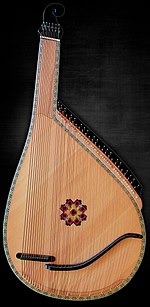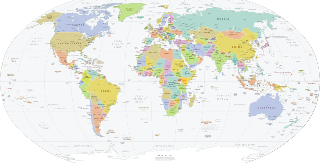
A country is a distinct part of the world, such as a state, nation, or other political entity. It may be a sovereign state or make up one part of a larger state. For example, the country of Japan is an independent, sovereign state, while the country of Wales is a component of a multi-part sovereign state, the United Kingdom. A country may be a historically sovereign area, a currently sovereign territory with a unified government, or a non-sovereign geographic region associated with certain distinct political, ethnic, or cultural characteristics.
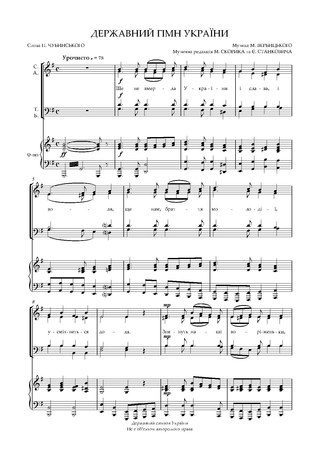
The national and state anthem of Ukraine is known by: its official edition's first line "Shche ne vmerla Ukrainy i slava, i volia", Ukrainian: Ще не вмерла України і слава, і воля, Ukrainian pronunciation:[ʃt͡ʃɛneˈwmɛrɫɑukrɑˈjinɪiˈsɫɑʋɑiˈʋɔlʲɐ], lit. 'Ukraine's glory and freedom/will have not yet perished'; its original title "Shche ne vmerla Ukraina", Ukrainian: Ще не вмерла Україна, Ukrainian pronunciation:[ʃt͡ʃɛneˈwmɛrɫɑukrɑˈjinɑ], lit. 'Ukraine has not yet perished'; and its official designation of the State anthem of Ukraine, Ukrainian: Державний гімн України, Derzhavnyi himn Ukrainy. It is one of the state symbols of the country.

The flag of Singapore was adopted in 1959, the year Singapore became self-governing within the British Empire. It remained the national flag upon the country's independence from Malaysia on 9 August 1965. The design is a horizontal bicolour of red above white, overlaid in the canton by a white crescent moon facing a pentagon of five small white five-pointed stars. The elements of the flag denote a young nation on the ascendant, universal brotherhood and equality, and national ideals.
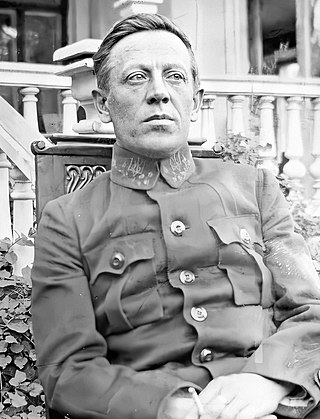
Symon Vasylyovych Petliura was a Ukrainian politician and journalist. He was the Supreme Commander of the Ukrainian People's Army (UNA) and led the Ukrainian People's Republic during the Ukrainian War of Independence, a part of the wider Russian Civil War.

The national flag of Ukraine consists of equally sized horizontal bands of blue and yellow.

Taras Hryhorovych Shevchenko, also known as Kobzar Taras, or simply Kobzar, was a Ukrainian poet, writer, artist, public and political figure, folklorist and ethnographer. His literary heritage is regarded to be the foundation of modern Ukrainian literature and, to a large extent, the modern Ukrainian language, though this is different from the language of his poems. Due to prosecution of the Ukrainian language, he also wrote selective works in "Great Russian" language. Shevchenko is also known for his many masterpieces as a painter and an illustrator.
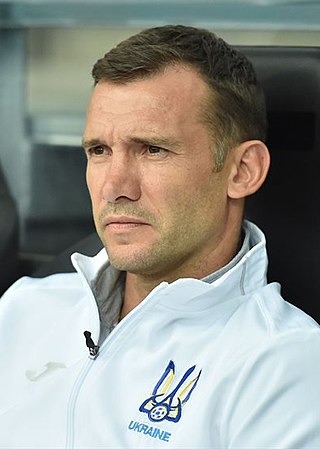
Andriy Mykolayovych Shevchenko, or Andrii Mykolaiovych Shevchenko is a Ukrainian football manager, a former professional football player and a former politician. Shevchenko played as a striker for Dynamo Kyiv, AC Milan, Chelsea and the Ukraine national team. He was most recently head coach of Serie A club Genoa. Shevchenko is considered one of the greatest strikers of all time and Ukraine’s greatest ever player. He is the all-time top scorer for the Ukraine national team with 48 goals.

The coat of arms of Ukraine is a blue shield with a golden trident. Officially referred to as the Emblem of the Royal State of Volodymyr the Great, or, colloquially, the tryzub, the insignia derives from the seal-trident of the Grand Dukes of Rus.

Ukrainian culture is composed of the material and spiritual values of the Ukrainian people that has formed throughout the history of Ukraine. Strong family values and religion, alongside the traditions of Ukrainian embroidery and folk music are integral aspects of the country’s culture. It is closely intertwined with ethnic studies about ethnic Ukrainians and Ukrainian historiography which is focused on the history of Kyiv and the region around it.

The Taras Shevchenko National University of Kyiv, also known as Kyiv University, Shevchenko University, or KNU, is in Kyiv, the capital of Ukraine. It is the third oldest university in Ukraine after the University of Lviv and University of Kharkiv. Its structure consists of 15 faculties and five institutes. The university is recognized as Ukraine's most prestigious university, and is the largest national higher education institution in the country.
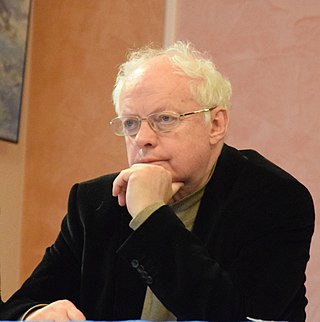
Myroslav Mykhailovych Skoryk was a Ukrainian composer and teacher. His music is contemporary in style and contains stylistic traits from Ukrainian folk music traditions.

The Taras Shevchenko Memorial is a bronze statue and stone relief-adorned wall located on the 2200 block of P Street NW in the Dupont Circle neighborhood of Washington, D.C., United States. It is one of many monuments in Washington, D.C. that honor foreign heroes who symbolize freedom in their native countries. Sculpted by Leo Mol, the memorial honors Taras Shevchenko (1814–1861), a Ukrainian poet and artist who influenced the development of modern Ukrainian literature.
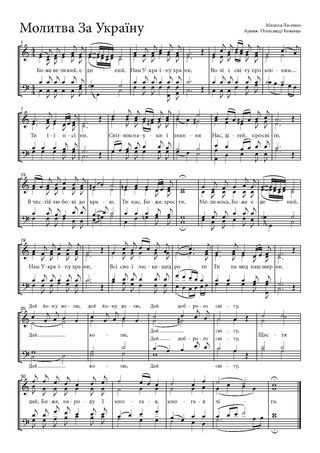
"Prayer for Ukraine" is a patriotic Ukrainian hymn published in 1885, which became a spiritual anthem of Ukraine. The text was written by Oleksandr Konysky, and the music was composed by Mykola Lysenko, first with a children's choir in mind. The song became the regular closing hymn in services of the Ukrainian Greek Catholic Church, the Orthodox Church of Ukraine and other churches. It gained national significance when it was performed by mass choirs during the Ukrainian War of Independence in 1917–1920. The hymn was intended to be an official spiritual anthem of Ukraine. It has closed sessions of oblast councils, and has been performed at major national functions.

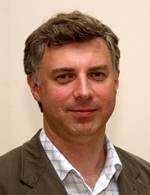
Serhiy Myronovych Kvit, is a Ukrainian literary critic, journalist, educator and social activist. Former champion of Ukraine in fencing (1984). Serhiy Kvit served as Rector (President) of the National University of Kyiv-Mohyla Academy from 2007 until 2014. He occupied the position of Minister of Education and Science of Ukraine in 2014-2016 when the progressive Laws on Higher Education (2014) and On Science and Research (2015) were adopted. In 2015 Serhiy Kvit signed an agreement that allowed Ukrainian scientists and businesses to fully participate in Horizon 2020 (H2020), the European Union’s flagship research program.

The national colours of Ukraine are usually identified as the combination of blue and gold in that order. These colours are the same as in the flag of Ukraine. The roots of Ukrainian national colours come from before Christian times when yellow and blue prevailed in traditional ceremonies, reflecting fire and water. The most solid proof of yellow and blue colours could be traced as far as the Battle of Grunwald at which militia formations from various lands of the Polish-Lithuanian Union participated. In maps of the 19th and 20th centuries, the territories of Ukraine were usually coloured yellow. The "gold" (Or) is nearly always represented by a shade of yellow, as there is no distinct colour "yellow" in heraldry; they both count as "Gold". There is a theory that the colors have arrived in the area of present-day Ukraine, together with the governor Prinz Władysław II Opolczyk, who established them to the Principality of Ruthenia on model of his native Upper Silesia.

Communist symbols have been banned, in part or in whole, by a number of the world's countries. As part of a broader process of decommunization, these bans have mostly been proposed or implemented in countries that belonged to the Eastern Bloc during the Cold War, including some post-Soviet states. In some countries, the bans also extend to prohibit the propagation of communism in any form, with varying punishments applied to violators. Though the bans imposed by these countries nominally target the communist ideology, they may be accompanied by popular anti-leftist sentiment and therefore a de facto ban on all leftist philosophies, such as socialism, while not explicitly passing legislation to ban them.
Shevchenko National Reserve is a historic-cultural reserve near Kaniv (Ukraine), known for the grave of Ukrainian poet Taras Shevchenko and a museum dedicated to his memory. The total area of the reserve is 45 hectares, the reserve includes eight cultural heritage sites, and borders the Kaniv Nature Reserve.

National Museum Taras Shevchenko is a museum in Kyiv, the capital city of Ukraine, dedicated to the life and work of the painter and national poet, Taras Shevchenko.

Saint Javelin is an Internet meme and fictional character depicted in a religious icon style as a saint-like figure cradling a modern weapon used in the Russian invasion of Ukraine, such as the FGM-148 Javelin anti-tank weapon. The meme was created by Christian Borys during the 2022 Russian invasion of Ukraine and became famous around the world, eventually resulting in other similar memes. The meme boosted morale and was used in merchandise products, resulting in more than a million dollars raised for humanitarian charities assisting Ukraine.






